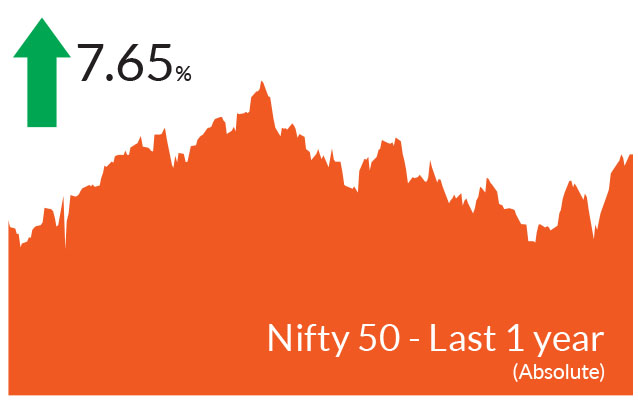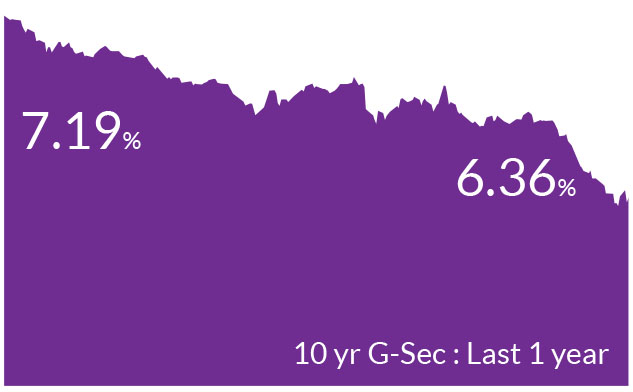► Markets do remain overvalued across the investment part of the economy and we may see
normalisation in some of these segments.
► We remain bullish on equities from a medium to long term perspective.
► Investors are suggested to have their asset allocation plan based on one's risk appetite and future goals in life.
► We remain bullish on equities from a medium to long term perspective.
► Investors are suggested to have their asset allocation plan based on one's risk appetite and future goals in life.


► Start of a shallow rate cycle post February cuts.
► Investors should add duration with every rise in yields, as yield upside limited.
► Mix of 10-year maturity and 1-5-year corporate bonds are best strategies to invest in the current macro environment.
► Selective Credits continue to remain attractive from a risk reward perspective given the improving macro fundamentals.
► Investors should add duration with every rise in yields, as yield upside limited.
► Mix of 10-year maturity and 1-5-year corporate bonds are best strategies to invest in the current macro environment.
► Selective Credits continue to remain attractive from a risk reward perspective given the improving macro fundamentals.
April was marked by significant volatility, with markets experiencing
both substantial gains and sharp declines. Reciprocal tariffs and their
impact on countries remained the global theme causing investors and
markets to shift to safer havens like gold. On April 2, the US
administration levied reciprocal tariffs on all countries with tariffs
ranging from 10-49% across countries. However, markets across the
globe including India improved as sentiment turned optimistic
following the pause on tariffs for 90 days. Indian equities ended higher
for the second consecutive month. The BSE Sensex and Nifty 50 closed
3.7% and 3.5% higher, while the NSE Midcap 100 advanced by 4.8% and
the NSE Smallcap 100 by 2.2%. Foreign Portfolio Investors (FPIs)
continued with their cautious stance in April but turned net buyers to a
small extent, buying US$0.5 bn. In contrast, DIIs bought equities worth
US$ 3.1bn. The rupee appreciated approx. 1% in April vis a vis the US
dollar This level is rupee's highest in 2025. The US dollar lost 3% in April
and was weaker against most currencies and around 5% weaker so far
in 2025.
With the announcement of RBI dividend this month, we expect banking liquidity to be approx. Rs 6 trn. Such high banking liquidity could lead to higher rally at the short end of the curve.
Meanwhile, the RBI relaxed liquidity coverage ratio (LCR) guidelines, which is expected to enhance credit availability and support growth in the banking and financial sectors.
Inflation falls below 4% : Headline inflation fell to a 6 year low of 3.3% in March from 3.6% in February 2025, led by a faster than expected moderation in food prices especially vegetables with the onset of winter months. Food inflation, a key component of CPI also eased to 2.7% in March from 3.8% in February 2025. Core inflation continues to remain below 4% for over 12 months. We anticipate headline inflation to remain low due to good rabi and kharif crop harvests and lower vegetable prices.
Rupee continues to appreciate in April : The rupee appreciated approx. 1% in April vis a vis the US dollar on account of foreign inflows in April and a weaker dollar itself which lost ground against most currencies. This level is rupee's highest in 2025. The US dollar lost 3% in April and around 5% in 2025 year to date.
US treasury yields narrow in April : While yields on US Treasuries narrowed by 4 bps over the month, the volatility around reciprocal tariffs and the uncertainty thereof led to swings in bond yields. Within a week, the yields rose to 4.50% from 4% levels after the announcement on tariffs by the US administration.
Key Market Events
RBI infuses liquidity, lower rates : The central bank continues to infuse liquidity into the system by way of open market operations(OMOs) worth Rs 125,000 cr in May. Earlier, in April the Reserve Bak (RBI) had infused Rs 80,000 cr in the system. Meanwhile, in April, the Monetary Policy Committee (MPC) of the RBI lowered the repo rate by 25 basis points to 6.0% - its second consecutive rate cut. More importantly, the RBI changed its stance from neutral to "accommodative", supported unanimously by all committee members. This decision comes against a backdrop of global uncertainty given the tariffs implemented by the US government across countries leading to a sell-off in equities globally and weak sentiment. The central bank's change in stance is suggestive of proactively supporting growth given the challenges that could be faced in such an environment and could imply a deeper rate cut cycle.With the announcement of RBI dividend this month, we expect banking liquidity to be approx. Rs 6 trn. Such high banking liquidity could lead to higher rally at the short end of the curve.
Meanwhile, the RBI relaxed liquidity coverage ratio (LCR) guidelines, which is expected to enhance credit availability and support growth in the banking and financial sectors.
Inflation falls below 4% : Headline inflation fell to a 6 year low of 3.3% in March from 3.6% in February 2025, led by a faster than expected moderation in food prices especially vegetables with the onset of winter months. Food inflation, a key component of CPI also eased to 2.7% in March from 3.8% in February 2025. Core inflation continues to remain below 4% for over 12 months. We anticipate headline inflation to remain low due to good rabi and kharif crop harvests and lower vegetable prices.
Rupee continues to appreciate in April : The rupee appreciated approx. 1% in April vis a vis the US dollar on account of foreign inflows in April and a weaker dollar itself which lost ground against most currencies. This level is rupee's highest in 2025. The US dollar lost 3% in April and around 5% in 2025 year to date.
US treasury yields narrow in April : While yields on US Treasuries narrowed by 4 bps over the month, the volatility around reciprocal tariffs and the uncertainty thereof led to swings in bond yields. Within a week, the yields rose to 4.50% from 4% levels after the announcement on tariffs by the US administration.
Equity Market View:
Given the current state of the markets, we reiterate the fact that markets are not unidirectional, making it crucial to stay invested to capitalize on any declines. While markets may remain volatile in the near term, investors should be mindful that long-term wealth growth is best achieved through an asset allocation approach and diversified investments across various types of funds. While from the highs of 2024, indices fell 16-25%, they have recovered half of the losses so far. On the macroeconomic front, brent crude is lower, headline inflation is below central bank's 4% target and we may see further interest rate cuts. Domestic liquidity has improved and is in surplus following injections by the central bank through various tools; however, domestic indicators do suggest moderating demand. This coupled with the global uncertainty will lead to moderation in growth in India. In the current scenario, we believe that earnings growth is unlikely to support valuation expansion in the near term.In terms of sectors, we are overweight financials, particularly NBFCs and pharma, we remain overweight the consumer discretionary segment through retailers, hotels, travel and tourism and have reduced our overweight in automobiles and remain underweight information technology. Renewable capex, manufacturers and power transmission/distribution companies, defense are the other themes we favour.
Notwithstanding expectations of lower growth in the short to medium term, India's long term growth story is supported by: 1) strong macro stability, characterized by improving terms of trade, a declining primary deficit, and declining inflation 2) annual earnings growth in the mid- to high-teens over the next 3-5 years, driven by an emerging private capital expenditure cycle, the re-leveraging of corporate balance sheets, and a structural increase in discretionary consumption.
Debt Market View:
After the reciprocal tariffs imposed initially, the US government has given a 90 day pause across countries and most countries including India are utilizing this opportunity for better terms of negotiation. This is what we had mentioned initially that the US may want to negotiate the terms of trade to bring down its trade deficit with its key trading partners. Having said that, one thing remains certain - the uncertainty on tariffs and its impact on global growth. The US will see its growth slowdown and we expect the US Fed to lower interest rates by another 50-75 bps. However, the tariffs could lower growth and this could mean rate cut cycle of 75-100 bps.On the macro side, inflation has slowed down and more than inflation, growth is the worry for the central bank. In its last monetary policy, RBI prioritized growth and is likely to support economy proactively. This combination of liquidity, rate cut and change in stance will keep the bond market happy. Rate cuts of 50 bps have been delivered so far and we expect another 25 bps in June and a pause thereafter. However, if the tariffs linger for long we could see further cuts of 25-50 bps.
A significant part of the bond market rally is behind us, incremental rate cuts and OMO's announcements would lead to near term rally in bond yields. Also, as per macro indicators like GDP, CPI which we believe would remain soft for FY26, there is nothing that can lead to significant upside in yields. Historically we have witnessed a 100-125 basis points bond rally in an easing cycle. We have already seen yields lower by 70- 75 bps over last 12 months. Hence, we expect limited rally from hereon. Once there is a resolution on US tariffs, and if they are significantly rolled back, the rally in India bond markets will likely be done. This is because clarity will emerge on CPI, and one will be able to gauge the impact on growth and start pricing terminal rate cut. Given the surplus liquidity, we expect the short bonds to outperform longer duration.
Source: Bloomberg, Axis MF Research.


